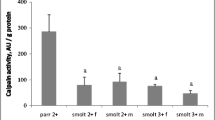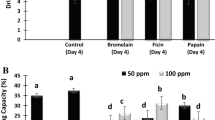Abstract
Calpain is known to be the most important endogenous protease responsible for degrading myofibril protein, thus affecting meat quality. This study aimed to investigate the activation of calpain and its potential influence in fish after slaughter. Calpain activity, expressions of the calpain inhibitor and activator (calpastatin and UK114, respectively), and effects of influencing factors on calpain activity and on the necessary Ca2+ activation concentration was investigated. Calpain activity increased significantly during the first 5 h of storage followed by rapid decline (P < 0.05). Three calpastatin expression bands were detected, and the 120-kDa calpastatin was significantly down-regulated with storage time (P < 0.05), whereas the level of UK114 in tilapia muscle was significantly up-regulated during postmortem storage (P < 0.05). Calpastatin and UK114 showed opposite effects on calpain activity; a significant decrease and increase in calpain activity were observed when crude calpain was incubated with calpastatin and UK114, respectively (P < 0.05). Furthermore, a significant increase was observed in calpain activity following co-treatment with calpastatin and UK114 (P < 0.05), but lower than that of treatment with UK114. The calpain activity in the UK114-treated group was higher than that of the control and calpastatin with the same Ca2+ concentration. Calpastatin inhibited calpain activation, whereas UK114 promoted the activation of calpain by reducing the concentration of Ca2+ required. Therefore, we propose that UK114 may increase calpain activity by inhibiting that of calpastatin.




Similar content being viewed by others
References
Ahmed Z, Donkor ON, Street WA, Vasiljevic T (2013) Activity of endogenous muscle proteases from 4 Australian underutilized fish species as affected by ionic strength, pH, and temperature. J Food Sci 78:1858–1864
Antonenkov VD, Ohlmeier S, Sormunen RT, Hiltunen JK (2007) UK114, a YjgF/Yer057p/UK114 family protein highly conserved from bacteria to mammals, is localized in rat liver peroxisomes. Biochem Bioph Res Co 357:252–257
Boehm ML, Kendall TL, Thompson VF, Goll DE (1998) Changes in the calpains and calpastatin during postmortem storage of bovine muscle. J Anim Sci 76:2415–2434
Chéret R, Delbarre-Ladrat C, Lamballerie-Anton MD, Verrez-Bagnis V (2007) Calpain and cathepsin activities in post mortem fish and meat muscles. Food Chem 101:1491–1496
D’Alessandro A, Zolla L (2013) Meat science: from proteomics to integrated omics towards system biology. J Proteomics 78:558–577
D’Alessandro A, Marrocco C, Rinalducci S, Mirasole C, Failla S, Zolla L (2012) Chianina beef tenderness investigated through integrated omics. J Proteomics 75:4381–4398
Delbarre-Ladrat C, Verrez-Bagnis V, Noël J, Fleurence J (2004a) Proteolytic potential in white muscle of sea bass (Dicentrarchus labrax L.) during post mortem storage on ice: time-dependent changes in the activity of the components of the calpain system. Food Chem 84:441–446
Delbarre-Ladrat C, Verrez-Bagnis V, Noël J, Fleurence J (2004b) Relative contribution of calpain and cathepsins to protein degradation in muscle of sea bass (Dicentrarchus labrax L.). Food Chem 88:389–395
DeMartino GN, Blumenthal DK (1982) Identification and partial purification of a factor that stimulates calcium-dependent proteases. Biochemistry-Us 21:4297–4303
Demartino GN, Croall DE (1984) Purification and characterization of a protein inhibitor of calcium-dependent proteases from rat liver. Arch Biochem Biophys 232:713–720
Dutt V, Kaur N, Gupta P, Gujar R, Grewal A, Gupta S, Dua A, Mittal A (2017) Efficient and modified protocol for zymography to detect muscle specific calpain activity. Biocatal Agr Biotech 10:96–103
Emori Y, Ohno S, Tobita M, Suzuki K (1986) Gene structure of calcium-dependent protease retains the ancestral organization of the calcium-binding protein gene. FEBS Lett 194:249–252
Farkas A, Nardai G, Csermely P, Tompa P, Friedrich P (2004) DUK114, the Drosophila orthologue of bovine brain calpain activator protein, is a molecular chaperone. 383:165–170
Fu QQ, Ge QF, Liu R, Wang HO, Zhou GH, Zhang WG (2017) Influence of modified atmosphere packaging on protein oxidation, calpain activation and desmin degradation of beef muscles. J Sci Food Agric 13:4508–4514
Gaarder MO, Bahuaud D, Veiseth-Kent E, Morkore T, Thomassen MS (2012) Relevance of calpain and calpastatin activity for texture in super-chilled and ice-stored Atlantic salmon (Salmo salar L.) fillets. Food Chem 132:9–17
Geesink GH, Nonneman D, Koohmaraie M (1998) An improved purification protocol for heart and skeletal muscle calpastatin reveals two isoforms resulting from alternative splicing. Arch Biochem Biophys 356:19–24
Gerelt B, Rusman H, Nishiumi T, Suzuki A (2005) Changes in calpain and calpastatin activities of osmotically dehydrated bovine muscle during storage after treatment with calcium. Meat Sci 70:55–61
Goll DE, Thompson VF, Li H, Wei W, Cong J (2003) The calpain system. Physiol Rev 83:731–801
Hosfield CM, Elce JS, Davies PL, Jia Z (1999) Crystal structure of calpain reveals the structural basis for Ca2+-dependent protease activity and a novel mode of enzyme activation. EMBO J 18:6880–6889
Hou GY, Huang M, Gao X, Li JY, Gao HJ, Ren HY, Xu SZ (2011) Association of Calpain 1 (CAPN1) and HRSP12 allelic variants in beef cattle with carcass traits. Afr J Biotechnol 10:13714–13718
Huang F, Huang M, Zhang H, Guo B, Zhang D, Zhou G (2014) Cleavage of the calpain inhibitor, calpastatin, during postmortem ageing of beef skeletal muscle. Food Chem 148:1–6
Inomata M, Hayashi M, Nakamura M, Saito Y, Kawashima S (1989) Properties of erythrocyte membrane binding and autolytic activation of calcium-activated neutral protease. J Biol Chem 264:18831–18838
Ji JR, Takahashi K (2006) Changes in concentration of sarcoplasmic free calcium during post-mortem ageing of meat. Meat Sci 73:395–403
Kawasaki H, Kawashima S (1996) Regulation of the calpain–calpastatin system by membranes (review). Mol Membr Biol 13:217–274
Kawasaki H, Emori Y, Suzuki K (1993) Calpastatin has two distinct sites for interaction with calpain—effect of calpastatin fragments on the binding of calpain to membranes. Arch Biochem Biophys 305:467–472
Lee WJ, Ma H, Takano E, Yang HQ, Hatanaka M, Maki M (1992) Molecular diversity in amino-terminal domains of human calpastatin by exon skipping. J Biol Chem 267:8437–8442
Lee HL, Santé-Lhoutellier V, Vigouroux S, Briand Y, Briand M (2008) Role of calpains in postmortem proteolysis in chicken muscle. Poultry Sci 87:2126–2132
Melloni E, Michetti M, Salamino F, Pontremoli S (1998a) Molecular and functional properties of a calpain activator protein specific for μ-isoforms. J Biol Chem 273:12827–12831
Melloni E, Michetti M, Salamino F, Sparatore B, Pontremoli S (1998b) Mechanism of action of a new component of the Ca2+-dependent proteolytic system in rat brain: the calpain activator. Biochem Bioph Res Co 249:583–588
Melloni E, Minafra R, Salamino F, Pontremoli S (2000) Properties and intracellular localization of calpain activator protein. Biochem Bioph Res Co 272:472–476
Molinari M, Carafoli E (1997) Calpain: a cytosolic proteinase active at the membranes. J Membr Biol 156:1–8
Nakamura M, Inomata M, Imajoh S, Suzuki K, Kawashima S (1989) Fragmentation of an endogenous inhibitor upon complex formation with high- and low-calcium requiring forms of calcium-activated neutral proteases. Biochemistry-Us 28:449–455
Pomponio L, Ertbjerg P (2012) The effect of temperature on the activity of μ- and m-calpain and calpastatin during post-mortem storage of porcine longissimus muscle. Meat Sci 91:50–55
Saccà E, Pizzutti N, Corazzin M, Lippe G, Piasentier E (2016) Assessment of calpain and caspase systems activities during ageing of two bovine muscles by degradation patterns of αII spectrin and PARP-1. Anim Sci J 87:462–466
Sentandreu MA, Coulis G, Ouali A (2002) Role of muscle endopeptidases and their inhibitors in meat tenderness. Trends food sci tech 13:400–421
Veiseth E, Shackelford SD, Wheeler TL, Koohmaraie M (2001) Effect of postmortem storage on mu-calpain and m-calpain in ovine skeletal muscle. J Anim Sci 79:1502–1508
Wilhelm AE, Maganhini MB, Hernández-Blazquez FJ, Ida EI, Shimokomaki M (2010) Protease activity and the ultrastructure of broiler chicken PSE (pale, soft, exudative) meat. Food Chem 119:1201–1204
Zhao Z, Wu F, Ding S, Sun L, Liu Z, Ding K, Lu J (2015) Label-free quantitative proteomic analysis reveals potential biomarkers and pathways in renal cell carcinoma. Tumor Biol 36:939–951
Acknowledgements
This research project was funded by the Natural Science Foundation of China (Grant numbers 31601533, 31401563); National System of Modern Agriculture Industrial Technology Specific (Grant number CARS-46), National Key Research and Development Program of China (Grant number 2016YFD0400201-6), Central Public-interest Scientific Institution Basal Research Fund, CAFS (NO. 2012TS03), Guangzhou science and technology plan project (Grant number 1561000228), and National Agricultural Product Quality Safety Risk Assessment Project Plan (Grant number GJFP201601504).
Author information
Authors and Affiliations
Corresponding author
Rights and permissions
About this article
Cite this article
He, Y., Huang, H., Li, L. et al. Changes of activated factors and activation of calpain in tilapia muscle during storage. Fish Sci 84, 889–895 (2018). https://doi.org/10.1007/s12562-018-1221-6
Received:
Accepted:
Published:
Issue Date:
DOI: https://doi.org/10.1007/s12562-018-1221-6




